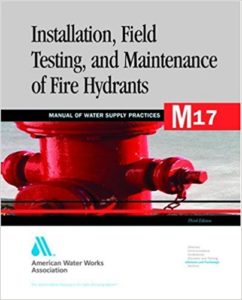Installation, Field Testing, and Maintenance of Fire Hydrants
Installation, Field Testing, and Maintenance of Fire Hydrants
This manual prepared by the AWWA Standards Committee on Fire Hydrants. It intended for use by persons responsible for the installation, operation, and maintenance of dry-barrel and wet-barrel fire hydrants. It is the fourth revision of the original manual, which was published in 1970
Before there were water distribution systems, water for fighting fires was available only from natural sources, such as rivers, lakes, and ponds, or from cisterns or barrels filled with water.The first large water distribution systems built during the seventeenth century in cities such as London and Boston. Over the course of many years, as the needs of growing populations became more sophisticated and complex, distribution systems were improved. Pipe materials improved, portable standpipes and valves were incorporated, and eventually, the forerunners of modern fire hydrants were used.
You can also Read Plastics and Sustainable Piping Systems
Installation, Field Testing, and Maintenance of Fire Hydrants Content
- Figures
![Fire Hydrants Fire Hydrants]()
- Tables
- Foreword
- Acknowledgments
- A Brief History of Fire Hydrants
- Dry-Barrel Hydrants: Definitions and Preferred Nomenclature
- Wet-Barrel Hydrants: Definitions and Preferred Nomenclature
- Inspection, Installation, Testing, and Placing the Hydrant in Service
- Maintenance
- Flow Tests
- Illustrated Guide to Dry-Barrel and Wet-Barrel Hydrant Nomenclature
- Bibliography
- Index
- AWWA Manuals
Two types of dry-barrel hydrants used during the mid-1800s: flush hydrants, which had the operating mechanism and hose connections in a pit with a cover plate; and post hydrants, which extended above grade. The post hydrant soon became predominant. There were two reasons for this. The obvious reason is that post hydrants were easier to find and to use, particularly in wintry, snowy climates. However, another reason may well have been more persuasive. In the early days, professional and volunteer fire-fighting brigades competed against each other. (Initially, insurance companies paid professional fire fighters to protect insured properties.)


Comments are closed.